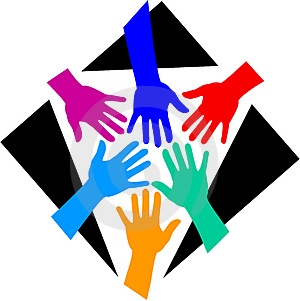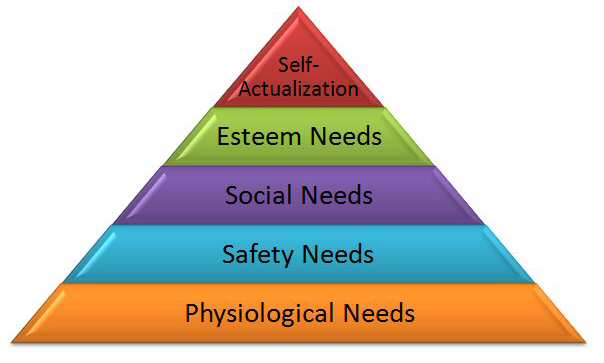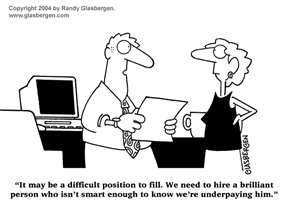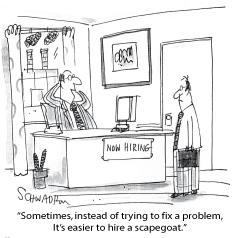Class Session 4
Class Session 4
February 16: Organizations as Human Relations

Ashleigh, Julianna, Kim, Sean, Tehmina
Abstract
This week we explored the Human Resource Model through the works of Bolman & Deal, Morgan, and Bennis. According to this model, workers can be seen as objects for exploitation or as individuals with needs that can be aligned to the needs of the organization. The human resource model assumes that the purpose of the organization is to serve human needs and that the relationship between the organization and the individual should be mutually beneficial. The readings presented the model, offered strategies for establishing the model in an organization, warned of the ways organizations exploit employees, and presented the principles of Great Groups. The class proceedings included a self-diagnostic questionnaire, video analysis, whole and small group discussions, and several
critiques of the Human Resource Model based on individual experiences. The discussion was robust and the cookies delicious.
Terms and Definitions
Domination – the oppression of lower-skilled workers to further the interests of the elite (e.g., 10,000 "lower-skilled" Egyptian people over a period of 20 years constructed the Great Pyramid of Giza for the benefit of the wealthy pharaohs; see Morgan, p. 293)
Egalitarianism- A philosophical idea where individuals are perceived to be treated as equals and have the same right
Employee Stock Ownership Plan (ESOP)- retirement program in which employees receive shares of the business rather than stock
Great Man Theories - early 1900 leadership theories based on research that identified qualities and characteristics of great social, political, and military leaders (e.g., Thomas Jefferson, Abraham Lincoln, and Mohandas Gandhi); it is believed that individuals are born with specific traits that clearly differentiate leaders from followers
Maslow's Hierarchy of Needs - theory about human needs suggesting that there is a hierarchy of needs with basic needs at the bottom, followed by safety needs, social needs, ego needs, and finally self actualization; very influential theory in managerial practice; ex. FedEx, Google - all basic needs and social needs are met so can focus on reaching one's potential
Self-actualization – fulfillment of an individual’s potential
X Theory – the managerial assumption that workers are lazy, passive, need to be led, and are resistant to change; managers control employees; ex. McWane (p. 120-121) cast iron pipe plant - people are a number, worst safety record in the industry
Y Theory– based on Maslow’s hierarchy of needs, the role of the manager is to create an environment that rewards and ultimately enables individual job satisfaction and personal goal attainment; the alignment of organizational tasks with employee self-interest; ex. Ben and Jerry's "When you give love, you receive love" (p. 400) and Southwest Airlines whose founder "cherishes and respects his employees" (p. 400)
TQM – Total Quality Management; a human resource management approach that emphasizes creativity, self-management, autonomy, and empowerment of the employees
Summary of Class Discussion
Reminders:
- GA interview day on February 27th; dessert on 26th at Dot’s house around 7pm
- Time to do program of study!
Activities:
We began with the “X-Y Theory Questionnaire,” each doing the assessment individually and then discussing the results in small groups. The ideal is alignment between the top and bottom halves, and the class consensus was that the Y theory is preferred. The lowest score on the top section was a 31.
The discussion then turned to the attributes of a Y leader and the application of Y Theory to potential leadership roles. The discussion included the disjuncture between what people learn in college and what they are required to do on the job. Pam cited her husband’s example of designing a wheelchair as opposed to a toy car and that work that “matters” has a real human face. On the other hand, Pam’s son worked 16 minutes of his 8 hour day, a demotivating experience. Discussion themes included communication, motivation, empowerment, human resource challenges, and the “goodness of fit.”
The next activity was the ‘Human Resource Movie Review’ in which the class watched a short clip on the Google work environment and then completed three questions for discussion. Strengths and weaknesses of working in such an environment were discussed, and the "Dark Side of Google" was exposed.
The final discourse was a brief commentary on people’s understandings of the Bennis article. Pam asked how “The Secret of Great Groups” could help us develop our own leadership style.
 |
Quote of the day:"When they align, it's kind of like a Kumbaya moment." ~Dr. Eddy**In reference to the X-Y questionnaire |
 |
Summary of Readings
Bolman & Deal: Chapter 6: People and Organizations
Maslow's Hierarchy of Needs
Human Resource Frame Assumptions (p.121-132)
- Individuals as objects for exploitation vs. Individuals’ needs aligned with the organizations’
- Pioneers: Mary Parker Follett (1918) and Elton Mayo (1933, 1945): questioned idea that workers only right was to a paycheck
- Their criticism was based on the unfairness of the status quo and recognition that the existing view was bad psychology
- Core assumptions:Human Needs (p. 122-126)
- Purpose of organization is to serve human needs, not vice versa
- Symbiotic relationship between people (need income, career, opportunity) and organizations (need new ideas, talents, energy)
- Goodness of fit between the system and the individual: if it is a bad fit, both sides will be exploited; if it is a good fit, both sides will benefit
Fit determined by 3 factors: organizational response to individuals needs for work, ability of employees to apply their skills in the job, and how effectively financial and life-style needs are fulfilled
- Controversy over concept of need still exist
- All have needs, but not all needs are the same, making ‘needs’ difficult to define
- {| class="captionBox" style="float: right"
| class="captionedImage" |
 |-
| class="imageCaption" | Maslow's Hierarchy of Needs
|}Nature - Nurture seesaw – sometimes genetic needs outweigh environmental ones, and sometimes vice versa
|-
| class="imageCaption" | Maslow's Hierarchy of Needs
|}Nature - Nurture seesaw – sometimes genetic needs outweigh environmental ones, and sometimes vice versa
What needs do people have? Maslow’s hierarchy of needs
- Theory X and Theory Y managers assumptions about people become self-fulfilling prophecies (McGregor, 1960)
- Theory X: subordinates are passive, need to be led. Hard version of this theory says workers require coercion and tight controls, the soft version says to avoid conflict when possible, and keep people happy
Theory Y: based on Maslow’s hierarchy: management’s role is to align their requirements with the self interest of the employee, then rely on the employee’s self-direction to get the task done
Personality and Organization: Argyris (1957,1964) felt organizations treated workers like children; saw conflict between the workers and the
structure in traditional organizational design and management, particularly in terms of task specialization which drives people to seek an escape
through one of six means:
- Withdraw (absenteeism, quitting)
- Psychologically withdraw (double up, diversions)
- Restrict output (deception, sabotage)
- Try to climb the hierarchy (seek better job)
- Form alliances (labor unions)
- Teach children work is unrewarding and advancement unlikely (evidenced in lack of work ethic in children of factory workers as compared to those of farmers)
Human Capacity and the Changing Employment Contract (p. 132-137)
- Skill Gap: conflict between need for adaptability in the workforce (focus on low costs and organizational efficiency) and need for loyalty (focus on people, invest in employees)
- Lean and Mean: More benefits than costs?
Focus on smaller workforce, more flexible, efficient, and less cost. Often results in downsizing or outsourcing which demoralize workforce and take
away knowledgeable, skilled, innovative, and loyal employees.
Ex. McWane (p. 120); Home Depot under Nardelli in 2001-2007
- Investing in People: Skilled, motivated workforce as a strategic advantage
Companies that recognize and respond to the needs of their employees and customers have higher performance than those that do not, and thus, attract better workers with higher motivation to do well in their jobs.
Ex. Nucor (p. 119); Southwest Airlines

Bolman & Deal: Chapter 7: Improving Human Resource Management'
Developing and Implementing an HR Philosophy '(p. 142-159)
Developing Human Capital (Investing in People + Addressing their Needs= Better Work Performance; Successful Company/Organization)
- Pioneer: Robert Owen (1771), capitalist, who believed in investing in human capital, will result in greater financial gains later. Owen believed in:
- Fair Labor and Wage practices
- Investing in the well being of his employees (housing, education, and health)
- Prohibited Corpral Punishment
- Invested in Training
Management Practice vs Organizational Philosophy (Resource Strategies) (p. 142-159)
- Build/Implement an HR Strategy - what differentiates you from everyone else in your field; a group of core values that inform all aspects of its business practices
- Hire the Right People- select individuals that understand the core values of the company; what impact are you looking to create in your company through your hiring practices?
- Keep Employees- identify those core values that employees deem most important. When employees feel connected to a company values, they become more committed. They want a say in the decision making process of the company, flexibility, transparency and be compensated fairly.
- Reward Well- competitive salaries is critical to building success in your company/organization
- Protect Jobs- Job security is not a realistic goal in these economic times. Employers are concern with how do they keep employees engaged and maintain their job performance
- Promote from Within-provides career opportunities for employees who are looking for professional growth and prevents employees leaving to another company for more challenging prospects
- Share the Wealth- increases employee loyalty and productivity
- Invest in Employees- providing opportunities for employees to grow, get training, and take on new challenges
- Empower Employees-motivate your employees to perform their best, you must provide a work environment where autonomy and creativity is encouraged
- Pioneer: Frederick Herzberg (1966)
- Provide Information and Support- transparency
- Encourage Autonomy and Participation- giving your employees freedom over how they work can actually make them more productive
- Redesign Work- encourage employees to develop/collaborate on innovative ideas
- Fostering Self Managing Teams - teaching groups of workers to take responsibility for managing themselves, and then giving them the power they need to do so
- Promote Egalitarianism - a belief in human equality
- Promote Diversity- Workplace diversity efforts can have a positive impact on the success of any company/organization ability to be innovative and profitable. Most organizations encourage an environment that values diversity. Organizations that are committed to diversity are focused and persistence who genuinely believes it’s the right core value/philosophy to emulate.
- TQM - is a comprehensive management approach that works horizontally across an organization, involving all departments and employees, plus seeking feedback from its constituents (consumers).
- Hackman and Wageman (1995)
- NUMMI (1985) -Joint venture between General Motors and Toyota to manufacture vehicles to be sold under both brands
- NUMMI's motto- " There are no managers, no supervisors, only team members"
- NUMMNI's impact:
- absenteeism down
- no delination between workers and executives (egalitarianism)
- self-managing teams
- Cross training was demanded of all employees
- Colloboration was essential to venture success
- Professional development training was offered (problem solving, interpersonal relations)
- Training and Organization Development
- NUMMNI's demise
- managerial ambivalence (fear of losing authority)
- NUMMNI's demise
- Group Intervention
- Kurt Lewin (1940)- one should focus on group change versus individual changes
- Sensitivity training (t-group)- individuals learn about themselves through interaction with each other
- Survey Feedback
- University of Michigan (Survey Research center)
- Rensis Likert - researched focused primarily on people and relationships
- Surveys- observing patters in human behavior
- Areas of Focus: motivation, communication, leadership styles and organizational climiate
- Evolution of OD
- Organization Development - a set of core values/ideas aimed to imrpove the company/organization ability adapt to change
Morgan: Chapter 9: The Ugly Face: Organizations as Instruments of Domination
Organization as domination (pp. 291-297)
- Domination is historically based with examples in history of the masses working for the goals of the political elite.
- Two sociologists studied the concept of organization and domination:
- Max Weber: main concern was to understand how different societies and epochs are characterized by different forms of social domination.
- Weber identified three different types of social domination (p. 294):
- Charismatic
- Traditional
- Rational-legal
- Weber identified three different types of social domination (p. 294):
- Max Weber: main concern was to understand how different societies and epochs are characterized by different forms of social domination.
Weber contended that when these three forms “impinge on one another” there exists “an uneasy tension" (pp. 294-295).
Robert Michels “saw in the politics of bureaucratic organization distinct oligarchic tendencies.” Michels contends that as leaders assume powerful roles, they tend to look at the world through a narrow set of lenses and “become preoccupied with their own way of looking at things” (p. 296).
How Organizations Use and Exploit their Employees (pp. 297-298)
- Morgan uses the play Death of a Salesman to link how organizations “exploit their employees” (p. 297).
- Organizations are unhealthy and promote work-related mental stress similar (although less dramatic) to the “exploitation found in slavery”
Organization, Class, and Control (pp. 298-304)
- Historical foundation found in the “hierarchical” and “class-based” societies from the early centuries (p. 298).
- With the onset of the Industrial Revolution/new technology and the advent “of the factory system . . .the employment of wage labor thus led the capitalist to place primary emphasis on the efficiency of labor time and to seek increasing control over the process of production” (pp. 300-301).
- The labor market can be divided into two categories (pp. 302-303):
- Primary labor market="highly-valued" workers who are indispensable to the organization’s success
- Secondary labor market=fungible and “lower-skilled” such as immigrant workers
Work Hazards, Occupational Disease, and Industrial Accidents (pp. 304-310)
- Morgan provides examples of accounts from lace, pottery, factories, clothing, and baking industries regarding over-worked and unhealthy young children and youth living short lives due to unhealthy conditions and poor nutrition.
- “'the bottom line’ tends to come first and safety second” (p. 310)
- 1970 Occupational Safety and Health Act has helped improve safety issues on the job but the process is largely dominated by safety officers cutting corners because they simply are lazy and do not want to be bothered with extra paperwork.
- the idea that is still prevalent in organizations is to allow an injured victim to sue rather than accept accountability.
Workaholism and social and mental stress (pp. 310-312)
- Work-related stress can cause coronary diseases, ulcers and mental breakdowns
- Stress is also related to physical violence in the workplace with some stressed employees even driven to commit homicide
- Some feel intense pressure to identify with their organization and force themselves to work constantly and fall prey to workaholism.
Organizational politics and the radicalized organization (pp. 313-315)
- In response to organizational exploitation, many view organizations as battlegrounds.
- This has given rise to unions further dividing the organizations along the lines of social divisions.
- Some organizations for example in mining and heavy industries are so divided that they have become “radicalized”
- Outsourcing to developing countries has undermined trade unions in the West.
Multinationals and the world economy (pp. 315-329)
- At the writing of the book, multinationals accounted for over 70% of world trade. Presently, the top 500 multinationals account for 70% of world trade (WTO Trade statistics).
- Major multinationals have emerged as world powers, since many are richer, and more powerful than nation-states.
- Multinationals create dependency instead of local autonomy.
- Alfred Chandler observes that the “visible hand” of management has replaced the “invisible hand” that Adam Smith saw guiding competitive markets.
- Multinationals have sought global dominance by sourcing raw materials at low prices and selling finished products at a profit.
- Mirow and Maurer in their book Webs of Power contend that multinationals are engaged in “international cartels” in collaborations to strengthen each other.
- Multinationals also use their clout to push their political agenda, an extreme example of which is the ITT’s involvement in the 1970 military coup against Chile’s elected Marxist President Salvador Allende.
- Developing countries are also caught in webs of debts to aid agencies like the IMF, the World Bank, and the USAID.
Strengths and limitations of the domination metaphor (pp. 329-333)
| Strengths |
Limitations |
| 1.Draws attention to the dark side of rationality and the dangers of a focus on profitability at human expense |
1.Is often linked to conspiracy theories of organization and society |
| 2.Provides a counterweight to traditional organizational theory which largely ignores values |
2.The latent consequence of the conspiracy theory is arousal of defenses, and assigning blame |
| 3.Forces us to consider whether domination is intrinsic to the process of organization and not its side effect |
3.Conspiracy theory implies that organizational domination occurs by design |
| 4. Can be used as an instrument of social change |
4.If organizations are equated with domination it is possible to overlook the non-dominating forms of organizations |
| 5. Helps us understand the reasons behind industrial unrest and sympathize with trade unions |
5.It is considered an extreme view that stirs unrest in industry and creates difficulties for managers |
Bennis: The Secret of Great Groups
Quick Takeaway Points:
- Few great accomplishments are ever the work of a single individual
- As a society we cling to the myth of the Lone Ranger (Great Man) when considering achievements
- There are 10 common principles that make up all great groups: shared dream, abandonment of individual egos for the dream, protection from the "suits", real or invented enemy, a belief that they are the winning underdogs, members pay a personal prices, product of meticulous recruiting, young ages, and real artists ship
- Great groups have a redefined role for leaders that consists of being a catalytic completer while providing direction and meaning, generating and sustaining trust, displaying a bias
toward action, risk taking, and curiosity, and purveying hope - A sense of mission is critical to the success of a great group
Examples of Great Groups:
- Michelangelo and the group of 16 who painted the www.christusrex.org/www1/sistine/0-Ceiling.html&docid=g37SXNCrv4w_BM&imgurl=http://www.christusrex.org/www1/sistine/0B-Ceiling.jpg&w=559&h=773&ei=znNBT7SAEYH10gGe8PDECA&zoom=1&iact=hc&vpx=287&vpy=343&dur=1108&hovh=264&hovw=191&tx=88&ty=119&sig=100846818640784821906&page=1&tbnh=174&tbnw=134&start=0&ndsp=11&ved=0CF4QrQMwBQ Sistine Chapel
- The 130,000+ individuals who were employed by the Manhattan Project
- The computer revolutionaries at Xerox's Palo Alto Research Center ( PARC )
- The teams that developed Apple and Mcintosh
- Lockheed Skunk Works team
- Walt Disney Studio animators
In Depth Notes:
- The genius of Great Groups is that they get remarkable people -- strong individual achievers -- to work together to get results
- Great groups also provide psychic support and personal fellowship and help generate courage
- Great groups are extraordinary in their own ways but there are 10 Principles common to Great Groups:
| Group Principle |
Group Principle Description |
| Great Groups Share a Dream |
All Great Groups believe that they are on a mission from God, that they could change the world, make a dent in the universe. They are obsessed with their work. It becomes not a job but a fervent quest. That belief is what brings the necessary cohesion and energy to their work. |
| Great Groups manage Conflict by Abandoning Individual Egos |
They manage conflict by abandoning individual egos to the pursuit of the dream. At a critical point in the Manhattan Project, George Kistiakowsky, a great chemist who later served as Dwight Eisenhower's chief scientific advisor, threatened to quit because he couldn't get along with a colleague. Project leader Robert Oppenheimer simply said, "George, how can you leave this project? The free world hangs in the balance." So conflict, even with these diverse people, is resolved by reminding people of the mission. |
| Great Groups are Protected From the "Suits" |
All Great Groups seem to have disdain for their corporate overseers and all are protected from them by a leader -- not necessarily the leader who defines the dream. In the Manhattan Project, for instance, General Leslie Grove kept the Pentagon brass happy and away, while Oppenheimer kept the group focused on its mission. At Xerox PARC, Bob Taylor kept the honchos in Connecticut (referred to by the group as "toner heads") at bay and kept the group focused. Kelly Johnson got himself appointed to the board of Lockheed to help protect his Skunk Works. In all cases, physical distance from headquarters helped. |
| Great Groups Have a Real or Invented Enemy |
Even the most noble mission can be helped by an onerous opponent. That was literally true with the Manhattan Project, which had real enemies -- the Japanese and the Nazis. Yet most organizations have an implicit mission to destroy an adversary, and that is often more motivating than their explicit mission. During their greatest years, for instance, Apple Computer's implicit mission was, Bury IBM. (The famous 1984 Macintosh TV commercial included the line, "Don't buy a computer you can't lift.") The decline of Apple follows the subsequent softening of their mission. |
| Great Groups View Themselves as Winning Underdogs |
World-changing groups are usually populated by mavericks, people at the periphery of their disciplines. These groups do not regard the mainstream as the sacred Ganges. The sense of operating on the fringes gives them a don't-count-me-out scrappiness that feeds their obsession. |
| Great Group Members Pay a Personal Price |
Membership in a Great Group isn't a day job; it is a night and day job. Divorces, affairs, and other severe emotional fallout are typical, especially when a project ends. At the Skunk Works, for example, people couldn't even tell their families what they were working on. They were located in a cheerless, rundown building in Burbank, of all places, far from Lockheed's corporate headquarters and main plants. So groups strike a Faustian bargain for the intensity and energy that they generate. |
| Great Groups Make Strong Leaders |
On one hand, they're all nonhierarchical, open, and very egalitarian. Yet they all have strong leaders. That's the paradox of group leadership. You cannot have a great leader without a Great Group -- and vice versa. In an important way, these groups made the leaders great. The leaders I studied were seldom the brightest or best in the group, but neither were they passive players. They were connoisseurs of talent, more like curators than creators. |
| Great Groups are the Product of Meticulous Recruiting |
It took Oppenheimer to get a Kistiakowsky and a Niels Bohr to come to his godforsaken outpost in the desert. Cherry-picking the right talent for a group means knowing what you need and being able to spot it in others. It also means understanding the chemistry of a group. Candidates are often grilled, almost hazed, by other members of the group and its leader. You see the same thing in great coaches. They can place the right people in the right role. And get the right constellations and configurations within the group. |
| Great Groups are Young |
The average age of the physicists at Los Alamos was about 25. Oppenheimer -- "the old man" -- was in his 30s. Youth provides the physical stamina demanded by these groups. But Great Groups are also young in their spirit, ethos, and culture. Most important, because they're young and naive, group members don't know what's supposed to be impossible, which gives them the ability to do the impossible. As Berlioz said about Saint-Saens, "He knows everything; all he lacks is inexperience." Great Groups don't lack the experience of possibilities. |
| Great Groups Portray Real Artist Ship |
Steve Jobs constantly reminded his band of Apple renegades that their work meant nothing unless they brought a great product to market. In the end, Great Groups have to produce a tangible outcome external to themselves. Most dissolve after the product is delivered; but without something to show for their efforts, the most talented assemblage becomes little more than a social club or a therapy group. |
The Role of the Leader in Great Groups
- The principles of Great Groups not only define the nature of the groups but they redefine the roles and responsibilities of the leader
- Group leaders vary widely in style and personality--some are facilitators, doers, contrarians
- Formal leaders are catalytic completers in that they take on roles that nobody else plays to help the group achieve its goal
- They understand the chemistry and dynamics of the group and work process
- They encourage dissent and diversity in the pursuit of a shared vision and understand the difference between healthy, creative dissent and self-serving obstructionism
- They are able to discern what people need at different times
- Leaders of Great Groups share four common behavioral traits
| Leader Trait |
Description of Trait |
| Provide Direction and Meaning |
They remind people of what's important and why their work makes a difference. |
| Generate and Sustain Trust |
The group's trust in itself -- and its leadership -- allows members to accept dissent and ride through the turbulence of the group process. |
| Display a Bias Toward Action, Risk Taking, and Curiosity |
A sense of urgency -- and a willingness to risk failure to achieve results -- is at the heart of every Great Group |
| Purveyor of Hope |
Effective team leaders find both tangible and symbolic ways to demonstrate that the group can overcome the odds. |
- There is no simple recipe for developing the leader behavioral traits
- To develop the traits we must rethink our notion of what collaboration means and how it is achieved
- Management training and educational institutions need to focus more on group development as a whole as well as individual development
The Role of the Mission in Great Groups
- Articulating a meaningful mission is the job of leaders at every level
- Both the sense of mission and the absence of the mission is critical to the employer and employee and the ultimate success of the institution
- Leaders must ensure that followers understand and feel connected to the mission
- When the mission is apparent, leaders can encourage uninspired work which leads to the success of the Great Group
- A shared purpose, on top of collaboration, communication, good leaders and followers, genuine empowerment, and personal commitment, is necessary for a group to be successful
- In conclusion, Bennis says that "Great Groups cannot be managed, only led in flight"
Leadership Theories that Can Apply to Great Groups
Transformational and Situational Leadership and Great Groups
Leaders of Great Groups demonstrate some of the following behaviors seen in Transformational Leadership:
- Transformational Leadership
- According to Bass (1985) transformational leadership motivates followers to do more than the expected by: raising followers’ levels of consciousness about the importance and value of specified and idealized goals, getting followers to transcend their own self-interest for the sake of the team or organization, and moving followers to address higher-level needs (as cited in Northouse, 2001, p. 135; Yukl, 2002, p. 253)
- One of the most important aspects of transformational leaders is that they “have transformed followers into more highly motivated followers who provide extra effort to perform beyond expectations of leader and follower.” (Couto as cited in Wren, 1995)
- The theory of transformational leadership consists of four factors/leader behaviors known as (Northouse, 2001):
- Charisma/Idealized Influence -leaders act as strong role models for followers; followers are able to identify with these leaders and as a result wish to imitate them.
- When demonstrating this behavior, leaders will place a great deal of trust in the followers and provide them with a vision and a sense of mission (p. 137)
- Inspirational Motivation -leaders communicate high expectations to followers, inspiring them through motivation to become committed to and a part of the shared vision in the organization (p. 138)
- When demonstrating this behavior, leaders will enhance team spirit or team motivation
- Intellectual Stimulation -leader stimulates followers to be creative and innovative, and to challenge their own beliefs and values as well as those of the leader and organization (p. 138)
- When demonstrating this behavior, leaders support their followers as they try new ways of dealing with organizational tasks and issues
- Individualized Consideration -leader acts as a coach and adviser while trying to assist individuals in becoming fully actualized (p. 138-139)
- When demonstrating this behavior, leaders will change or adaptive their leadership style to best fit the followers. This means that leaders while change whether they are coaching, delegating, supporting, or directing the followers
- Charisma/Idealized Influence -leaders act as strong role models for followers; followers are able to identify with these leaders and as a result wish to imitate them.
- According to Bass (1985) transformational leadership motivates followers to do more than the expected by: raising followers’ levels of consciousness about the importance and value of specified and idealized goals, getting followers to transcend their own self-interest for the sake of the team or organization, and moving followers to address higher-level needs (as cited in Northouse, 2001, p. 135; Yukl, 2002, p. 253)
Leaders of Great Groups demonstrate some of the following behaviors seen in Situational Leadership:
- Situational leadership stresses that “leadership is composed of both directive and supportive dimensions, and each has to be applied appropriately in a given situation…to be an effective leader requires that an individual adapt his or her style to the demands of different situations,” (Northouse, 2001).
- Situational leadership consists of four approaches to leading which stem from directive and supportive behaviors: directive behaviors “assist the group members in goal accomplishment through directions, establishing goals, evaluations, timelines, role definition, and one-way communication between the leader and follower,” (Northouse, 2001) whereas supportive behaviors, “involve two-way communication between the leader and the follower, problem solving, praising of the follower, sharing information about the leader, and listening,” (Northouse, 2001)
- Directing consists of the leader demonstrating high directive and low supportive behaviors. This form of leadership is focused on goal achievement and the leader gives the follower instructions on what the goals are and how the goals are to be accomplished while closely supervising the follower.
- Coaching consists of the leader demonstrating high directive and high supportive behaviors. This form of leadership is focused on goal achievement and maintenance of the subordinates socio-emotional needs.
- Supporting consists of the leader demonstrating high supportive and low directive behaviors. In this form of leadership, the leader will provide praise to the follower, elicit input and feedback from the follower, and give the control of accomplishing goals to the follower and then remain available to the follower for problem solving.
- Delegating consists of low supportive and low directive behaviors. In this form of leadership, the leader will give the goal of accomplishing the tasks completely to the subordinate, after discussing what exactly the goal is, and will not be overly available if the follower needs clarification
Hill's Model for Team Leadership

A Short Course in Human Relations and Leadership:
==
Wegmans: A Great Place to Shop and a Great Place to Work
Further readings of interest:
Bentley, T., Zhao, F., Reames, E.H., & Reed, C. (2004). Frames we live by. Professional Educator, 26 (2), 39-44. Retrieved from [1]]
Brewer, P. D., & Brewer, K. L. (2010). Knowledge Management, Human Resource Management, and Higher Education: A Theoretical Model. Journal Of Education For Business, 85(6), 330-335. doi:10.1080/08832321003604938
Cuoto, R.A. (1995). The transforming of transformational leadership. In J.T. Wren (Ed.), The leaders companion: Insights on leadership through the ages (pp. 102-107). New York: The Free Press.
[Griffin. R. W., & O'Leary-Kelly, A. (2004). The dark side of organizational behavior. San Francisco, US: Jossey-Bass.
Miller, J.L. (2000). Motivation in the human resource frame. Retrieved from: http:fsweb.bainbridge.edu/techprep/Motivation.htm
Northouse, P.G. (2001). Leadership: theory and practice (4th ed). Thousand Oaks, CA: Sage Publications, Inc.
Philip M. Rosenzweig, P.M & Nohria, N . (1994). Influences on Human Resource Management Practices in Multinational Corporations. Journal of International Business Studies, 25(2), 229-251.
Shuck, M., Rocco, T. S., & Albornoz, C. A. (2011). Exploring employee engagement from the employee perspective: implications for HRD. Journal Of European Industrial Training , 35 (4), 300-325. doi:10.1108/03090591111128306
Wang, J., Hutchins, H. M., & Garavan, T. N . (2009). Exploring the strategic role of human resource development in organizational crisis management. Human Resource Development Review, 8 (1), 22-53.
Yukl, G. (2002). Leadership in organizations. Upper Saddle River, New Jersey: Prentice-Hall, Inc.


